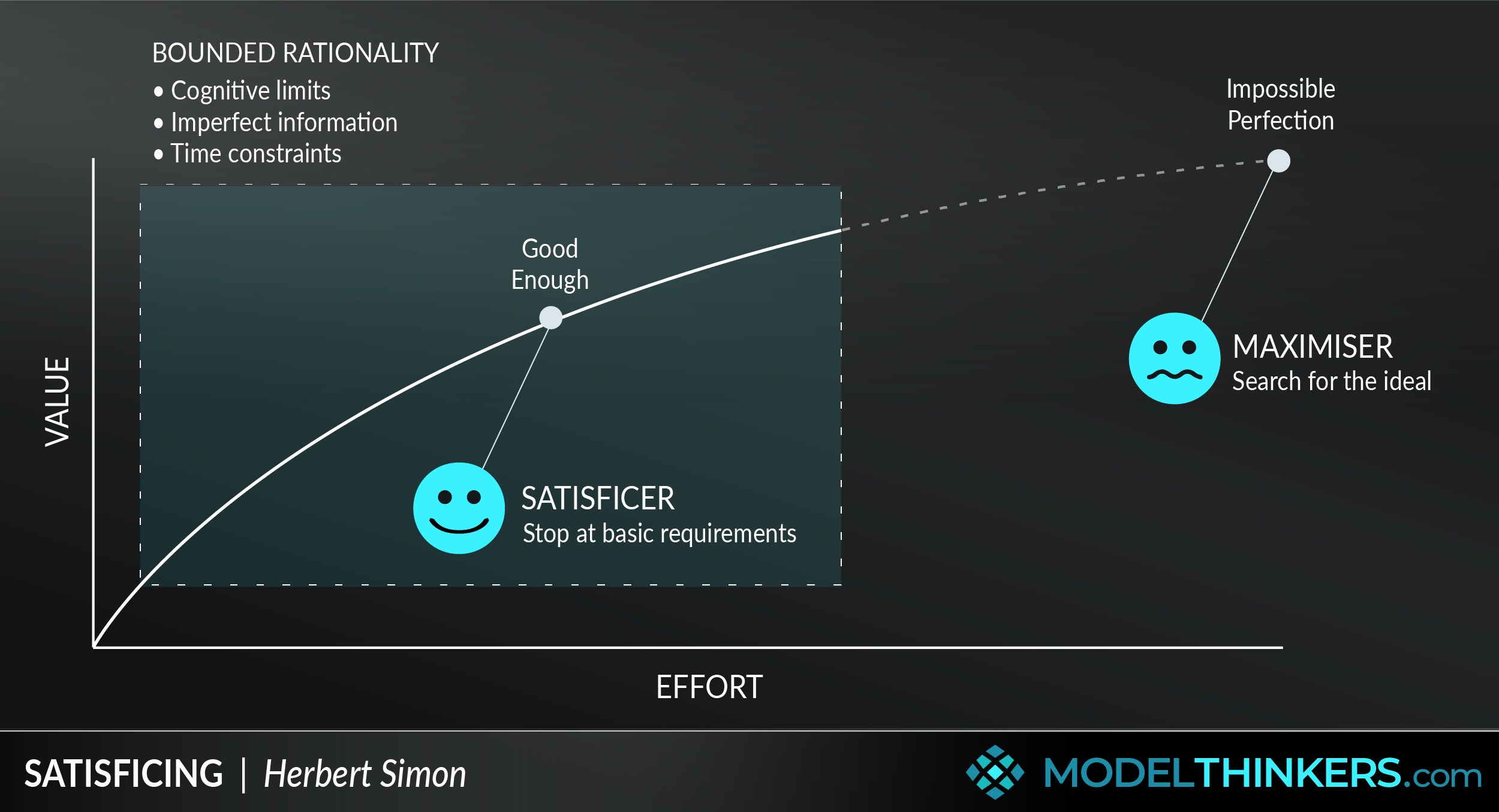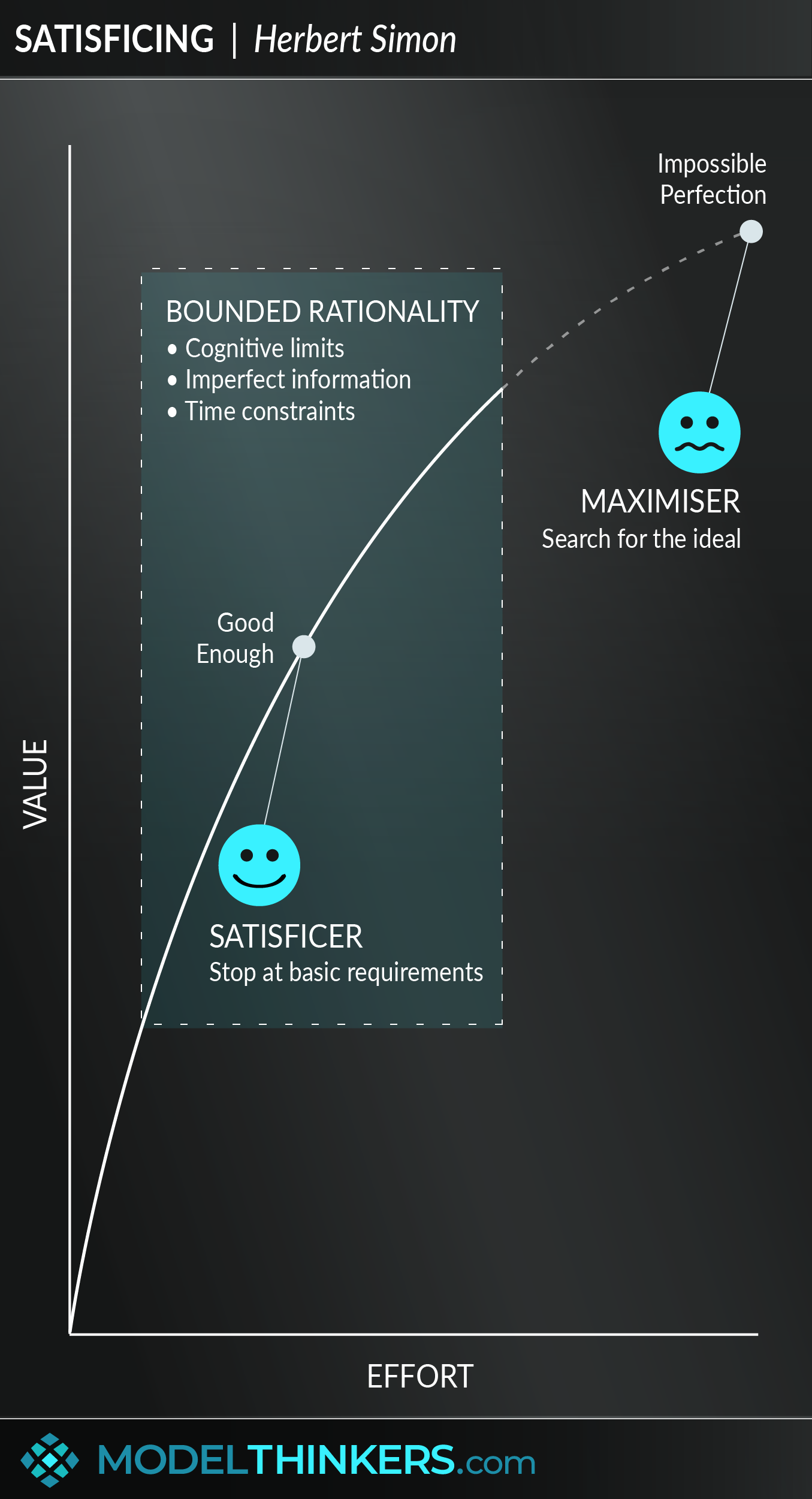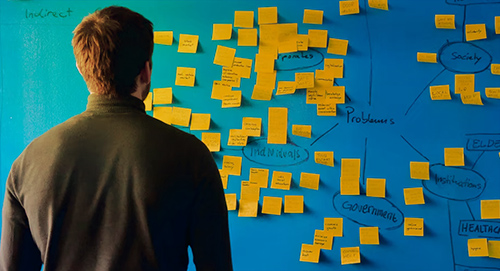

 0 saved
0 saved
 27.6K views
27.6K views








Whether you’re struggling with perfectionism, working to an ambitious timeline, want to be happier, or just need help making a decision, Satisficing might be the model that you’re looking for.
A combination of the words ‘satisfying’ and ‘sufficing’, Satisficing is a heuristic for making decisions with the goal of reaching an adequate result, rather than an ideal one.
SATISFICING AND BOUNDED RATIONALITY.
Herbert Simon first described Satisficers and their opposite of Maximisers in the 1950s, in his work on Bounded Rationality, which is the idea that individuals make decisions with limited rationality. Simon pointed to Bounded Rationality stemming from the complexity of a problem, the lack of reliable information related to it in the context of limits of cognitive ability of humans, and time constraints. Despite this, Simon explained that Maximisers seek out optimal solutions to a problem through an exhaustive search of all possible options with the aim of applying a rational decision-making process.
Through arguing the case for Bounded Rationality, Simon challenged the view that decision-making is a rational process where a fully optimal solution is possible, let alone feasible. He therefore advocated for the pragmatic approach of Satisficing or settling for 'good enough' once the basic requirements are met, rather than pursuing an impossible optimal solution.
A KEY TO HAPPINESS?
A number of studies have identified links between chronic Maximising tendencies with impacts on self-esteem, and increases in depression. Psychologist and best-selling author Daniel Levitin has noted that, "Recent research in social psychology has shown that happy people are not people who have more; rather, they are people who are happy with what they already have. Happy people engage in satisficing all of the time, even if they don't know it."
As a result, it's believed that embracing Satisficing might improve your happiness in a number of ways:
-
Save time and money: investigating options until an adequate solution becomes apparent means that you don’t over-invest your time, resources, or energy.
-
Reduce regret: by stopping at the first solution that meets your needs you will reduce regret of other possibilities that you won’t even explore.
-
Focus on what works: rather than what is possible or out in the world, the Satisficer focuses on taking the next step of reducing a pain point or meeting a known need which is particularly impactful in complexity where an ideal future state is likely unrealistic to define let alone reach.
-
Reduce cognitive overload: by stopping when basic requirements are met, you potentially avoid overwhelm and the Paradox of Choice.
-
Invest in making your choice work: rather than investing more time and resources into finding the right option, Satisficers are able to invest their saved resources into making the basic option work more effectively for them.
COUNTLESS IMPLICATIONS.
You might start applying this approach on a personal level. For example, use it to choose the groceries you buy, the house you live in, and right up to selecting a life partner. However, Simon’s work also has implications for companies. Indeed, decisions made for large companies often have more complex information and, it could be argued, that Bounded Rationality will particularly apply in the context of large, complex decisions.
Beyond that, it has implications for product design, sales and business more generally based on an understanding that people will generally make a decision based on a quick assessment of removing pain or addressing a need, rather than a deep investigation and search for the optimal approach through rational deliberation. Indeed, marketing empires have been built on this understanding through the use of simple tag lines and clever branding.
IN YOUR LATTICEWORK.
Simon’s broader work around Bounded Rationality served as a foundation for Behavioural Economics, which went further than seeing rationality as bounded and framed it as fundamentally limited in our human condition, particularly captured through Kahneman’s Fast and Slow Thinking.
Satisficing helps to explain the Lock-in-Effect, and the dangers of Maximising in regard to happiness can be better understood in terms of Framing. Satisficing can also help to inform strategies being developed as part of the 4Ps of Marketing, and help choice architects to apply nudges using the EAST Framework.
The Pareto Principle helps to explain the danger of diminishing returns when investing time beyond meeting basic requirements, or beyond the ‘20’ that will provide ‘80’ of the value. When stopping with a few options, rather than creating an exhaustive search, try using the Pugh Matrix to check them against your current state and select 'good enough'. And finally, the Kano Model provides an interesting view of where Satisficing is most appropriate, and where it might be worth stretching to go beyond the basic requirements to deliver greater value.




- Start by defining your basic requirements.
Establish the pain point that you are trying to target and/or the need that you are trying to better meet. Ask yourself, what would allow me/us/them to be satisfied moving forward? This is not about defining an ideal future or looking at the market to see what’s possible, it’s about focusing on your basic requirements and the next step only.
- Timebox and refine your search.
Use Parkinson’s Law to timebox the investment you intend to make in your research. The trick here is to be smart about the scope of your investigation, focusing on the most likely options that will meet your requirements.
- Stop looking.
When you find an option that meets your basic requirements, avoid the temptation to continue looking into something that might work better. Commit to your choice and invest your energy into making it work.
There is some debate about whether Satisficing is a positive trait, or just a pragmatic acceptance of our inadequacies that compromises what we should aspire towards. In other words, should we just be satisfied with Satisficing? Wouldn’t it be better to strive for that rational decision-making process that will lead to the best option possible? With that frame, it’s easy to see how Satisficing can lead to ‘just settling’ rather than striving to improve and push us to be better. This is particularly the case when starting with one's own basic requirements might not give you a sense of what is possible through options you have not yet considered.
Perhaps a compromise involves being strategic about when and where to use this approach. Knowing when it’s worthwhile to explore more optimal options, even with the challenges of rational decision making, versus when to embrace Satisficing.
Cross-Cultural Studies of Maximisers and Well Being.
This study, by Barry Shwartz of Paradox of Choice fame, took a cross-cultural investigation into well-being and examined how it links to Satisficing versus Maximisers. They found that “in societies where choice is abundant (i.e., U.S. and Western Europe), maximizers reported less well-being than satisficers, and this difference was mediated by experienced regret. However, in the non-western society (China), maximizing was unrelated to well-being. Although in China maximizing was associated with more experiences of regret, regret had no substantial relationship to well-being.”
“Hence, whether western societies’ abundance of choice and the high value attached to personal choice is a blessing or a curse may depend on how the individual tends to cope with this (excess of) freedom.”
Finding a Partner.
Another study examined how Maximisers pursued finding a relationship, with the people who went to exhaustive lengths to find ‘the one’. However, despite their additional efforts, Maximisers did not necessarily find a more optimal solution that made them happier.
d
Herbert Simon coined the term ‘Bounded Rationality’ in his book Models of Man, in 1947. At the time, it was posed as a counter to the mathematical and economic modelling of decision-making that assumed a rational process based on maximising utility. In that respect, it served as an important foundation for Behavioural Economics and the broader view of humans as irrational agents, more than just Bounded Rationality.
Simon further expanded on the idea of Satisficing in his 1956 paper, Rational choice and the structure of the environment, as a way of explaining cognitive heuristics.
 My Notes
My Notes
Oops, That’s Members’ Only!
Fortunately, it only costs US$5/month to Join ModelThinkers and access everything so that you can rapidly discover, learn, and apply the world’s most powerful ideas.
ModelThinkers membership at a glance:






“Yeah, we hate pop ups too. But we wanted to let you know that, with ModelThinkers, we’re making it easier for you to adapt, innovate and create value. We hope you’ll join us and the growing community of ModelThinkers today.”






















































































